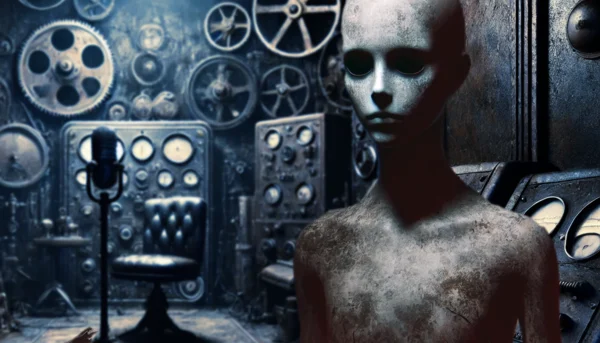The Rise of AI in Voice Acting: Narrativ.ai and Its Implications
In the ever-evolving landscape of digital media and advertising, artificial intelligence has emerged as a disruptive force, challenging traditional notions of creativity and human involvement. At the forefront of this revolution stands Narrativ.ai, a pioneering platform that has captured the attention of the industry with its innovative approach to voice replication and digital advertising.
Narrativ.ai’s technology represents a significant leap forward in the application of AI to creative fields. By leveraging advanced machine learning algorithms, the platform can create startlingly accurate digital replicas of human voices, offering brands the tantalizing prospect of utilizing celebrity voices or top-tier voice talent at a fraction of the traditional cost. This development has sent ripples through the advertising world, prompting discussions about the future of voice acting and the role of human talent in an increasingly automated industry.
The SAG-AFTRA Agreement: A Double-Edged Sword
The recent deal struck between Narrativ.ai and SAG-AFTRA, the union representing actors and other media professionals, marks a pivotal moment in the integration of AI into the entertainment industry. On the surface, this agreement appears to be a win-win situation: performers gain the opportunity to monetize their voice in new ways, while brands gain access to a potentially limitless supply of high-quality voiceover work [source].
However, this arrangement raises profound questions about the nature of artistic expression and the value of human creativity. While the deal ensures fair compensation and gives performers control over how their digital voices are used, it also opens the door to a future where the unique talents of voice actors could be reduced to mere data points in an AI algorithm. This commodification of human artistry threatens to undermine the very essence of what makes performances by talents like D.C. Douglas so compelling and irreplaceable.
The Technological Marvel and Limitations of Narrativ.ai
To fully appreciate the strengths and weaknesses of AI-generated voices, it’s crucial to understand the technology that powers platforms like Narrativ.ai. At its core, the system relies on deep learning neural networks, trained on vast amounts of audio data to recognize and replicate the patterns, cadences, and unique characteristics of individual voices.
The Process: From Human Voice to Digital Replica
The creation of a digital voice replica involves several complex steps:
- Data Collection: Hours of high-quality audio recordings of the target voice are gathered, covering a wide range of emotional tones, pacing, and linguistic contexts.
- Audio Processing: The collected data is cleaned, normalized, and segmented into usable chunks for machine learning.
- Feature Extraction: The AI analyzes the audio to extract key features such as pitch, timbre, rhythm, and pronunciation patterns.
- Model Training: Using advanced neural network architectures, the AI is trained to generate speech that mimics the extracted features.
- Fine-Tuning: The model undergoes iterative refinement to improve accuracy and natural-sounding output.
- Text-to-Speech Integration: The trained model is integrated with text-to-speech systems, allowing it to generate speech from written input.
While this process can produce remarkably accurate voice replicas, it is not without significant limitations. The AI’s output is fundamentally constrained by the data it was trained on, leading to potential issues with flexibility, emotional range, and the handling of novel or complex linguistic situations [source].
The Uncanny Valley of Voice
One of the most persistent challenges faced by AI-generated voices is the phenomenon known as the “uncanny valley” – a concept originally developed in robotics but equally applicable to voice synthesis. As AI-generated voices approach human-like quality, they often enter a zone where small imperfections become increasingly noticeable and unsettling to listeners.
These imperfections can manifest in various ways:
- Subtle inconsistencies in emotional tone
- Unnatural transitions between phonemes
- Lack of micro-variations in pitch and rhythm that characterize natural speech
- Inability to adapt to contextual nuances that human actors intuitively understand
The result is a voice that, while technically impressive, often fails to fully connect with the audience on an emotional level. This disconnect can be particularly problematic in advertising and branding, where emotional resonance is crucial for engagement and message retention.
The Irreplaceable Value of Human Voice Acting: D.C. Douglas as a Paradigm
In contrast to the limitations of AI, human voice actors like D.C. Douglas bring a depth of experience, emotional intelligence, and creative intuition that cannot be replicated by algorithms. The value of human performance in voice acting extends far beyond mere technical proficiency in speech production.
The Art of Interpretation and Emotional Conveyance
At the heart of great voice acting lies the ability to interpret a script, understand its subtext, and convey complex emotions through vocal performance. D.C. Douglas, with his years of experience across various mediums, exemplifies this artistry. His performances are not simply about reading words aloud but about bringing characters and messages to life in a way that resonates deeply with the audience.
Consider the following aspects of human voice acting that AI struggles to replicate:
- Emotional Nuance: Human actors can convey subtle emotional states through minute variations in tone, pacing, and emphasis. These nuances often carry more meaning than the words themselves.
- Contextual Understanding: Experienced voice actors like Douglas instinctively grasp the broader context of a script, adjusting their performance to suit the overall tone and message of the piece.
- Creative Interpretation: Human actors can offer creative insights and interpretations that might not be apparent from the script alone, adding depth and dimension to the performance.
- Adaptive Performance: In live sessions, voice actors can take direction and make real-time adjustments, something that AI systems are currently incapable of doing.
The Human Touch in Branding and Advertising
In the realm of branding and advertising, the human element in voice acting becomes even more crucial. A brand’s voice is not just a vehicle for delivering information; it’s an essential component of its identity and a key factor in building emotional connections with consumers.
Human voice actors bring several irreplaceable qualities to branding efforts:
- Authenticity: Consumers are increasingly savvy and can often detect the difference between a genuine human performance and an AI-generated one. The authenticity of a human voice builds trust and credibility.
- Brand Personality: Skilled voice actors can embody and project a brand’s personality in ways that AI cannot, creating a consistent and relatable brand voice across different campaigns and platforms.
- Emotional Engagement: Human performances can evoke genuine emotional responses in listeners, creating memorable experiences that are crucial for brand recall and loyalty.
- Flexibility: Human actors can adapt their performance to suit different target demographics, cultural contexts, and campaign objectives, providing versatility that AI systems struggle to match.
The Philosophical Implications of AI in Creative Fields
The rise of AI in voice acting and other creative domains raises profound philosophical questions about the nature of creativity, consciousness, and the human experience. As we grapple with these technologies, we must consider their broader implications for society, art, and our understanding of what it means to be human.
The Nature of Creativity and Consciousness
At the core of the debate surrounding AI in creative fields is the question of whether true creativity can emerge from non-conscious systems. While AI can produce outputs that mimic human creativity, there is ongoing philosophical debate about whether these outputs constitute genuine creativity or merely sophisticated imitation.
Key philosophical considerations include:
- Intentionality: Human creativity is often driven by intention, emotion, and lived experience. Can an AI system, lacking consciousness and self-awareness, truly create with intention?
- Originality: While AI can combine existing elements in new ways, can it generate truly original ideas that aren’t merely recombinations of its training data?
- Meaning and Context: Human artists imbue their work with meaning drawn from personal and cultural contexts. Can AI understand and incorporate these deeper layers of meaning?
The Ethics of Digital Replication
The ability to create digital replicas of human voices raises ethical concerns that extend beyond issues of compensation and consent. We must consider the long-term implications of a world where human performances can be synthetically recreated and manipulated.
Ethical considerations include:
- Identity and Ownership: To what extent does an individual own their voice, and what rights should they have over its digital replication?
- Posthumous Usage: Should AI-generated voices of deceased performers be allowed, and if so, under what circumstances?
- Authenticity in Media: As AI-generated content becomes more prevalent, how do we maintain trust and authenticity in media and advertising?
The Shortsightedness of Over-Reliance on AI in Voice Acting
While the allure of cost-saving and scalability offered by AI voice technology is undeniable, an over-reliance on these systems represents a shortsighted approach that fails to consider the long-term implications for brand value, audience engagement, and the creative industry as a whole.
The False Economy of AI Voice Acting
At first glance, the cost savings offered by AI voice technology may seem attractive to corporate decision-makers. However, this perspective fails to account for the hidden costs and potential risks associated with replacing human talent with AI:
- Loss of Brand Distinctiveness: As more brands adopt AI voices, there’s a risk of homogenization in brand sound, making it harder for companies to stand out in a crowded marketplace.
- Reduced Emotional Impact: The subtle emotional cues that human actors provide can significantly impact the effectiveness of advertising. Losing this emotional resonance could lead to decreased engagement and reduced ROI on marketing efforts.
- Potential Backlash: As consumers become more aware of AI-generated content, there’s a risk of negative reactions to brands perceived as inauthentic or overly reliant on artificial performances.
- Missed Creative Opportunities: Human voice actors often contribute creative ideas and interpretations that can elevate a project. By relying solely on AI, brands miss out on this valuable input.
The Long-Term Value of Human Creativity
Investing in human talent like D.C. Douglas represents a commitment to quality, authenticity, and creative excellence that can yield significant long-term benefits for brands:
- Building Brand Equity: Consistent use of high-quality human performances helps build a strong, recognizable brand voice that resonates with audiences over time.
- Fostering Innovation: Collaboration with human creatives can lead to unexpected innovations and fresh approaches that AI systems are not equipped to generate.
- Adapting to Cultural Shifts: Human actors can quickly adapt to changing cultural contexts and sensitivities, ensuring that brand communications remain relevant and appropriate.
- Creating Memorable Experiences: The unique qualities of human performance create memorable moments that stick with audiences, driving long-term brand recall and loyalty.
Epilogue: The Enduring Superiority of Human Voice Acting
As we navigate the complex landscape of AI and its applications in creative fields, it becomes increasingly clear that the value of human talent, particularly in voice acting, cannot be overstated. While AI technologies like Narrativ.ai offer intriguing possibilities and potential efficiencies, they ultimately fall short in replicating the depth, nuance, and authentic connection that human performers like D.C. Douglas bring to their work.
The decision to invest in human voice talent is not merely a choice between two comparable options; it is a strategic commitment to quality, authenticity, and long-term brand value. In a world increasingly saturated with artificial experiences, the human touch in voice acting stands out as a beacon of genuine emotion and connection.
For brands and content creators looking to make a lasting impact, the choice is clear: the irreplaceable artistry of human voice actors like D.C. Douglas offers a level of quality, emotional resonance, and creative potential that AI simply cannot match. As we move forward in this age of technological advancement, it is crucial to recognize and cherish the unique value that human creativity brings to our media landscape, ensuring that the art of voice acting continues to thrive and evolve in the hands of talented professionals.









